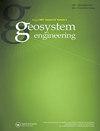A review of calcined clays and ceramic wastes as sources for alkali-activated materials
IF 1.1
Q3 GEOSCIENCES, MULTIDISCIPLINARY
引用次数: 14
Abstract
ABSTRACT Expanding and optimising the raw materials base in accordance with increasing ecological and technical requirements is one of the determining factors of a promising future for the constantly evolving alkali-activated materials (AAMs). Because of the development of the chemistry of the inorganic materials, the range of potentially suitable aluminosilicates has changed and expanded continuously throughout the history of AAMs. Relatively recently, efforts to find more types of adequate, alternative aluminosilicate sources, in addition to conventional granulated blast furnace slag, fly ash, and metakaolin, have led to extensive studies that have substantially increased understanding around the suitability of various natural sources and wastes for production of AAMs. In recent decades, calcined clays and ceramic wastes have become significant as an alumino-silicate sources for AAMs. Extensive research forms the theoretical and practical bases for the application of calcined clays, which are diverse in composition and structure, for effective cement production. This paper reviews recent developments in the field of alkali-activated cement-based systems using calcined clays containing different amounts of 1:1 and/or 2:1 type clay and secondary minerals, and ceramic wastes, including their suitability aspects, processing features, chemical reactivities, controlling factors, potential for application.煅烧粘土和陶瓷废料作为碱活性材料来源的研究进展
摘要根据日益增长的生态和技术要求扩大和优化原材料基础是不断发展的碱活性材料(AAM)前景光明的决定因素之一。由于无机材料化学的发展,在AAM的整个历史中,潜在合适的铝硅酸盐的范围不断变化和扩大。最近,除了传统的粒状高炉矿渣、粉煤灰和偏高岭土外,还努力寻找更多类型的合适的替代铝硅酸盐来源,这导致了广泛的研究,大大提高了人们对各种天然来源和废物是否适合生产AAM的了解。近几十年来,煅烧粘土和陶瓷废料已成为AAM的铝硅酸盐来源。广泛的研究为应用成分和结构多样的煅烧粘土进行有效的水泥生产奠定了理论和实践基础。本文综述了使用含有不同量的1:1和/或2:1类型粘土和次生矿物的煅烧粘土以及陶瓷废料的碱活性水泥基系统领域的最新进展,包括它们的适用性、加工特征、化学反应性、控制因素和应用潜力。
本文章由计算机程序翻译,如有差异,请以英文原文为准。
求助全文
约1分钟内获得全文
求助全文

 求助内容:
求助内容: 应助结果提醒方式:
应助结果提醒方式:


